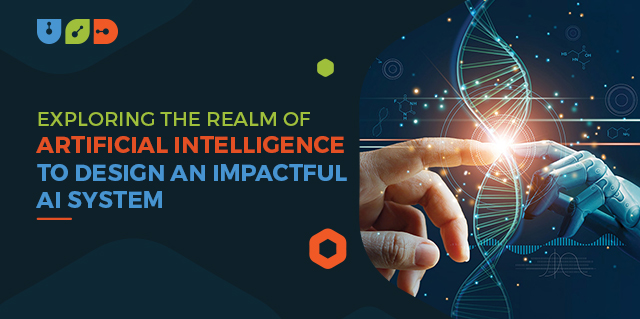Table of Contents
Toggle“Artificial Intelligence offers many benefits but requires natural intelligence to design it creatively.”
ChatGPT became the center of public attention after going live for global users. The reason is its ability to process text conversations, swiftly process the questions within, and rapidly respond with useful textual information. The gaining momentum was evident by ChatGPT surpassing the number of active users on Google shortly after its launch. It makes millions wonder about the immense opportunities possible through Artificial Intelligence and such platforms.
Google was the second to join this revolution through its AI system, Bard, endorsing the domain’s worthiness. So, this writing will address the meaning, functionality, importance, advantages, and types of AI applications. It will also outline the tools, platforms, and role of AI in business to guide readers on how to create an AI. The last section focuses on AI programming essentials, languages, and development processes. Let’s begin with probing into what it is and how it works.
What is Artificial Intelligence?
Artificial Intelligence, also known as AI, is the domain that focuses on the development of intelligent software capable of performing tasks that usually require human intellect. At the core, it aims to create systems that can mimic cognitive functions such as learning, problem-solving, speech recognition, and decision-making. The ultimate goal is to design machines that can execute these tasks autonomously, adapting and improving their performance over time.
It is permeating numerous facets of modern life, from virtual personal assistants like Siri and Alexa to advanced medical diagnostics and autonomous vehicles. As technology continues to evolve, so does its scope and potential, shaping industries, revolutionizing problem-solving approaches, and prompting profound transformations. Its interdisciplinary nature, drawing from computation, mathematics, and cognitive psychology, underscores its dynamic and influential role in the digital revolution.
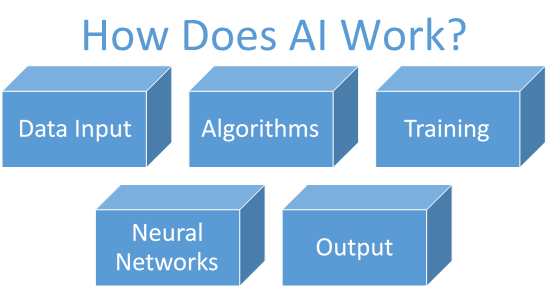
How Does AI Work?
Artificial Intelligence operates through a complex interaction of algorithms, data, and computational power. Basically, an AI system aims to simulate human intelligence by processing information, learning from it, and making decisions or predictions. The key components that define how AI works include:
1. Data Input
AI systems require a vast amount of data to function effectively. This data can be structured or unstructured and serves as the foundation for training and learning.
2. Algorithms
Algorithms are the sets of rules and instructions that govern AI systems. Machine learning algorithms, in particular, enable AI to learn from data, identify patterns, and make predictions or decisions without explicit programming.
3. Training
During the training phase, the system is exposed to labeled datasets, allowing it to adjust its parameters and improve its performance over time. The more data the system processes, the better it becomes at recognizing patterns and making accurate predictions.
4. Neural Networks
In deep learning, a subset of machine learning, neural networks attempt to mimic the structure and function of the human brain. Layers of interconnected nodes process information hierarchically, enabling the system to recognize intricate patterns and features.
5. Output
The system produces an output based on its analysis and learning. This output can range from categorizing images and translating languages to making strategic decisions in gaming or optimizing business processes.
Why is AI Important?
Artificial Intelligence is of paramount importance in today’s technological landscape due to its transformative impact on various aspects of our lives, industries, and global systems. Several factors underscore the significance of AI, such as:
1. Efficiency and Automation
It excels in business process automation of repetitive and time-consuming tasks, boosting efficiency across industries. It can handle massive datasets and complex computations at speeds far beyond human capacity, allowing organizations to streamline processes and achieve higher productivity.
2. Innovation and Problem-solving
It fosters innovation by introducing novel approaches to problem-solving. Machine learning algorithms can uncover patterns, analyze trends, and generate insights from vast datasets, providing valuable information for decision-making and strategy formulation.
3. Personalization and User Experience
It enhances user experiences by enabling personalization in various applications, from content recommendations on streaming platforms to tailored product suggestions in e-commerce. Its adaptability caters to individual preferences, fostering customer satisfaction and loyalty.
4. Medical Advancements
In healthcare, it contributes to diagnostic accuracy, drug discovery, and personalized treatment plans. It accelerates the analysis of medical imaging, identifies potential risks, and supports medical professionals in delivering more precise and timely care.
5. Autonomous Systems
It is crucial in the development of autonomous systems, such as self-driving cars and drones. These technologies leverage it to perceive and respond to their environments, contributing to advancements in transportation, logistics, and public safety.
6. Global Competitiveness
Nations and industries that invest in it gain a competitive edge. AI-driven innovations drive economic growth, enhance research and development capabilities, and position countries at the forefront of technological leadership in the global arena.
7. Societal Impact
It has the potential to address societal challenges, from predicting and mitigating the impact of natural disasters to aiding in climate change research. Its applications extend to fields like education, where it can support personalized learning experiences.
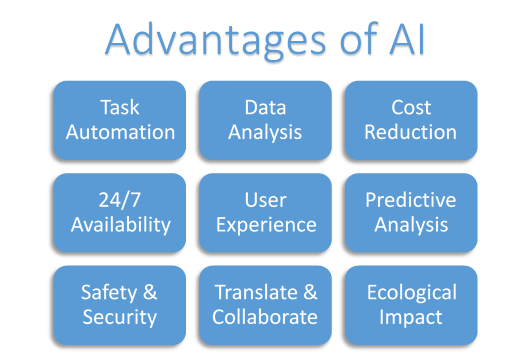
Advantages of AI
The advantages of Artificial Intelligence are manifold, contributing to advancements across various industries and reshaping the way we live and work. Here are some key advantages:
1. Task Automation
It enables the automation of repetitive tasks, significantly enhancing efficiency. Automation not only reduces human workload but also allows for faster and more accurate completion of tasks, improving overall productivity.
2. Data Analysis and Insights
It excels at processing vast amounts of data, extracting patterns, and generating valuable insights. This capability is crucial for businesses in making informed decisions, identifying trends, and gaining a competitive edge in the market.
3. Cost Reduction
Through automation and improved efficiency, it contributes to cost reduction. Organizations can streamline operations, optimize resource allocation, and minimize human error, leading to significant financial savings.
4. 24/7 Availability
AI software, unlike human workers, can operate 24/7 without fatigue. This constant availability is particularly beneficial in tasks requiring continuous monitoring, such as cybersecurity or customer support.
5. Enhanced User Experiences
It contributes to personalized user experiences by understanding individual preferences and behaviors. It is evident in recommendation systems, virtual assistants, and chatbots that provide tailored interactions, improving customer satisfaction.
6. Predictive Maintenance
In industries like manufacturing, it is utilized mainly for predictive maintenance and optimization. By analyzing data from sensors and machinery, it can predict when equipment is likely to fail, allowing for proactive maintenance and minimizing downtime.
7. Safety and Security
It enhances safety in various domains, from self-driving cars that prioritize road safety to surveillance systems that identify potential security threats. Machine learning algorithms can quickly analyze and respond to real-time data, mitigating risks.
8. Translation and Communication
AI-powered language translation services facilitate global communication by breaking down language barriers. It promotes collaboration, knowledge-sharing, and cultural exchange on a worldwide scale.
9. Environmental Impact
Employing IoT tech helps to optimize energy consumption, monitor environmental changes, and contribute to sustainable practices. Smart grids, for instance, balance energy distribution and reduce waste. Smart warehouses and smart homes actively optimize resource consumption.
Types of Artificial Intelligence
Artificial Intelligence is categorized into different types based on its capabilities and functionalities. These classifications reflect the varying levels of complexity in AI systems. The main types of AI are:
1. Narrow or Weak AI
This type is designed for a specific task or a narrow set of tasks. It excels in performing predefined functions and is not capable of generalizing its knowledge to other domains. Examples include virtual assistants like Siri and Alexa.
2. General or Strong AI
It refers to a system with the ability to understand, learn, and apply knowledge across a wide range of tasks, similar to human intelligence. This level is aspirational and not yet fully realized, as most current AI software is narrow in its focus.
3. Machine Learning
Machine Learning (ML) is a subset of AI that focuses on developing algorithms that allow systems to learn from data and improve their performance over time without explicit programming. It includes supervised learning, unsupervised learning, and reinforcement learning.
4. Deep Learning
Deep learning is a specialized form of machine learning that involves neural networks with multiple layers (deep neural networks). It excels in tasks such as image and speech recognition, natural language processing, and complex pattern analysis.
5. Reinforcement Learning
Reinforcement Learning involves training AI models through trial and error. The system receives feedback in the form of rewards or penalties based on its actions, enabling it to learn optimal strategies in dynamic environments.
6. Natural Language Processing (NLP)
NLP focuses on enabling machines to understand, interpret, and generate human language. It is essential for applications like chatbots, language translation, and sentiment analysis.
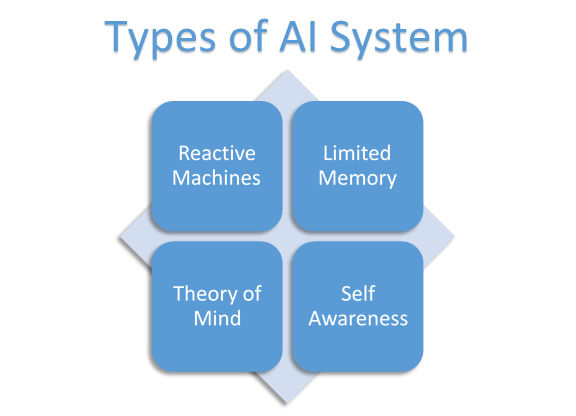
7. AI System
Expert AI Systems programs mimic the decision-making abilities of a human expert in a specific domain. They use a knowledge base and inference engine to solve complex problems. AI software is further categorized into four groups depending on their purpose and scope.
1. Reactive Machines
Task-specific and devoid of memory, they operate based on predefined rules. An exemplary illustration is Deep Blue, the IBM chess program famous for defeating Garry Kasparov in the 1990s. Deep Blue can recognize chessboard configurations and make predictions within the game but is unable to utilize past experiences for future decision-making due to its absence of memory.
2. Limited Memory
Limited memory programs possess the ability to retain and use past experiences to shape future decisions. Notable examples include decision-making functions in self-driving cars. By incorporating memory, these systems enhance their adaptability and responsiveness.
3. Theory of Mind
Theory of mind, originating from psychology, takes on a distinct form. Systems falling into this category exhibit social intelligence, enabling them to comprehend human emotions. Equipping programs with a “theory of mind” can infer human intentions and predict behavior for integrating them with human teams.
4. Self-awareness
The concept of self-awareness characterizes AI systems in this category. Machines possessing self-awareness exhibit a sense of self akin to consciousness. Notably, AI with self-awareness comprehends its current state. It’s important to note that, as of now, AI software with true self-awareness remains speculative and has not yet been realized.
Applications of AI in Business
Artificial Intelligence (AI) has become a transformative force in various industries, reshaping traditional business models and optimizing processes. Companies are not only improving their internal operations but also optimizing supply chain systems and financial performance through this tech. In this section, we will explore its diverse applications across different sectors.
1. AI in Construction
In the construction industry, it streamlines project management, enhances safety, and improves efficiency. AI-driven algorithms analyze data from construction sites, enabling predictive maintenance of equipment, optimizing schedules, and identifying potential safety hazards.
2. AI in Healthcare
It is revolutionizing healthcare by improving diagnostics, personalizing treatment plans, and accelerating drug discovery. Machine learning algorithms analyze patient data to identify patterns and predict disease risks, while natural language processing (NLP) facilitates efficient data management and information extraction.
3. AI in the Retail Industry
In retail, it aids in customer engagement, demand forecasting, and inventory management. Recommendation systems use machine learning to analyze customer preferences and provide personalized product suggestions, enhancing the overall shopping experience.
4. AI in Fintech
The financial technology sector leverages it for fraud detection, risk management, and customer service. AI algorithms analyze transaction patterns to identify potential fraudulent activities, while chatbots powered by natural language processing enhance customer interactions.
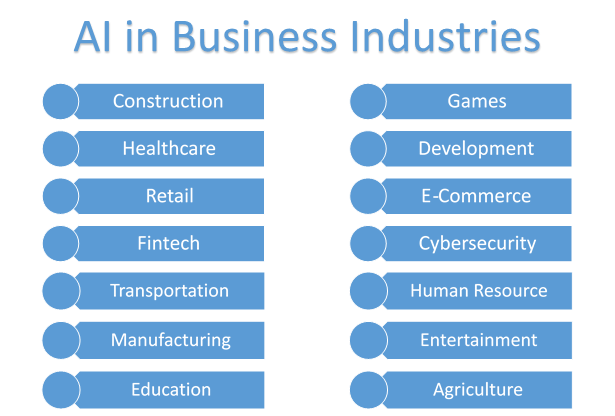
5. AI in Transportation
AI plays a crucial role in optimizing transportation systems. In autonomous vehicles, AI algorithms process real-time data from sensors to navigate and make decisions. Additionally, it is useful for route optimization, predictive maintenance of vehicles, and traffic management.
6. AI in Manufacturing
In manufacturing, it enhances production efficiency, quality control, and predictive maintenance. AI-driven robots and automation systems streamline assembly lines, while machine learning algorithms analyze data to identify defects and optimize production processes.
7. AI in Education
It is transforming education through personalized learning experiences, intelligent tutoring systems, and data-driven insights. AI applications analyze student performance data to tailor educational content, providing adaptive learning experiences.
8. AI in Games
In the gaming industry, it enhances player experiences through non-player character (NPC) behaviors, procedural content generation, and adaptive difficulty levels. AI algorithms simulate human-like decision-making, creating immersive and challenging gaming environments.
9. AI in Software Development
AI tools are increasingly used in software development for code optimization, bug detection, and project management. Machine learning algorithms analyze code repositories to identify patterns, suggest improvements, and automate certain development tasks.
10. AI in E-Commerce
E-commerce platforms leverage it for personalized marketing, recommendation engines, and inventory management. AI algorithms analyze customer behavior, preferences, and purchase history to provide tailored product recommendations, increasing sales and customer satisfaction.
11. AI in Cybersecurity
In the realm of cybersecurity, it aids in threat detection, anomaly detection, and automated response mechanisms. AI algorithms analyze network traffic patterns to identify potential security threats, providing a proactive defense against cyberattacks.
12. AI in Human Resource
It streamlines human resource processes by automating resume screening, candidate matching, and employee engagement. Chatbots powered by natural language processing handle routine HR inquiries, while AI analytics assist in workforce planning and talent management.
13. AI in Entertainment
In the entertainment industry, it helps in content recommendation, video analysis, and virtual reality experiences. Recommendation algorithms analyze user preferences to suggest movies, music, or shows, creating a personalized entertainment landscape.
14. AI in Agriculture
AI applications in agriculture include precision farming, crop monitoring, and yield prediction. AI-driven drones and sensors collect data on soil conditions, crop health, and weather patterns, allowing farmers to make informed decisions and optimize crop yields.

AI Software for Nonprofits
Incorporating AI into nonprofit operations empowers organizations to operate more efficiently, engage donors effectively, and address social challenges with data-driven precision. The application of AI technologies ensures that nonprofits can maximize their resources, ultimately leading to a more significant and lasting positive impact on the communities they serve.
1. Donor Management
It empowers donor management programs to facilitate nonprofits in cultivating stronger relationships with supporters. Such programs analyze donor behavior, preferences, and historical data to personalize engagement strategies. Through predictive analytics, nonprofits can identify potential major donors and tailor targeted campaigns to maximize fundraising efforts.
2. Fundraising
It streamlines fundraising initiatives by optimizing campaign strategies. Intelligent algorithms analyze donor data to predict the success of various fundraising approaches, enabling nonprofits to focus resources on the most effective methods. Chatbots equipped with natural language processing assist in donor interactions, making the donation process seamless and personalized.
3. Addressing Social Issues
It contributes to addressing social issues by analyzing vast datasets to identify patterns and trends. This data-driven approach helps nonprofits better understand the root causes of social problems, leading to more informed decision-making and targeted interventions.
4. Disaster Management
In times of crisis, it assists nonprofits in disaster management by analyzing real-time data to assess the impact, predict trends, and optimize resource allocation. Machine learning algorithms can predict the occurrence of natural disasters, enhancing readiness and response capabilities.
5. Time & Cost Reduction
AI software helps nonprofits save valuable time and resources through automation. Routine administrative tasks, data entry, and reporting can be automated, allowing organizations to focus more on their core missions. This efficiency not only reduces costs but also enhances the overall impact of nonprofit initiatives.
AI Tools and Services
Artificial Intelligence tools and services have become integral components across industries, driving innovation and enhancing operational efficiency. AI development platforms and software are getting their fair share of recognition in the following domains.
1. Machine Learning Platforms
Machine learning platforms empower businesses to develop, deploy, and manage machine learning models. These platforms offer a range of tools for data preprocessing, model training, and evaluation, enabling organizations to extract meaningful insights from vast datasets.
2. Natural Language Processing (NLP)
NLP tools and services enable computers to understand, interpret, and generate human language. Applications include chatbots for customer service, sentiment analysis for social media, and language translation services, enhancing communication in various domains.
3. Computer Vision Services
Computer vision tools enable machines to interpret and make decisions based on visual data. In industries such as healthcare, automotive, and manufacturing, computer vision facilitates image recognition, object detection, and quality control.
4. Speech Recognition Systems
Speech recognition tools convert spoken language into text, enabling hands-free communication and transcription services. These systems find applications in virtual assistants, transcription services, and voice-controlled devices, enhancing user experiences.
5. AI-Enhanced Analytics Platforms
AI-driven analytics platforms leverage machine learning algorithms to analyze complex datasets, providing valuable insights for decision-making. These platforms help businesses identify trends, predict outcomes, and optimize strategies across various domains.
6. Robotic Process Automation (RPA)
RPA tools automate repetitive, rule-based tasks, increasing operational efficiency and reducing human error. Organizations use RPA for tasks such as data entry, invoice processing, and customer service, freeing up human resources for more strategic activities.
7. AI-Based Cloud Services
Major cloud service providers offer AI-based services, including AI-as-a-Service (AIaaS). These services provide scalable and cost-effective access to AI technologies, allowing businesses to integrate machine learning, natural language processing, and computer vision into applications.
8. Predictive Analytics Platforms
Predictive analytics tools utilize AI to forecast future trends based on historical data. Businesses leverage these platforms for demand forecasting, risk management, and personalized marketing strategies, optimizing decision-making processes.
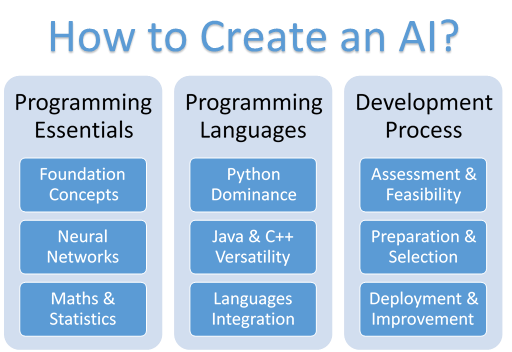
How to Create an AI System?
Creating a robust AI system involves a deep understanding of programming essentials, the selection of appropriate programming languages, and a well-defined development process. Let’s explore each crucial aspect in detail.
1. AI Programming Essentials
The first stage in developing an AI system is to understand the following programming essentials.
a) Foundational Concepts of AI
Before delving into the intricacies of AI programming, it’s essential to grasp the foundational concepts of artificial intelligence. Understanding machine learning basics involves exploring supervised learning, unsupervised learning, and reinforcement learning. Additionally, become familiar with concepts like algorithms, models, and training data.
b) Neural Networks and Their Structure
To build a strong foundation, delve into the structure and function of artificial neural networks. Understand layers, nodes, weights, and activation functions that constitute neural networks. Study how the solutions architect lays the foundation for employing AI technologies or solutions.
c) Mathematics and Statistics for AI
A solid foundation in mathematics and statistics is crucial for AI development. Explore linear algebra, probability distributions, statistical measures, hypothesis testing, and calculus to understand their applications in AI.
2. Programming Languages for AI
Following are the suitable programming languages that aid in the creation of AI software.
a) Python Dominance in AI Development
Python stands out as a primary language for AI due to its simplicity, versatility, and an extensive ecosystem of libraries. Libraries like TensorFlow, PyTorch, and sci-kit-learn offer tools for data preprocessing, model training, and evaluation.
b) Versatility of Java and C++
While Python dominates AI development, Java and C++ find their place in specific applications. Java’s scalability makes it fit for large-scale applications, and frameworks like Deeplearning4j enhance its capabilities. Leverage C++ for high-performance AI implementations, particularly in computer vision and gaming AI.
c) Integration of Programming Languages
Understanding how to integrate Python, Java, and C++ components in AI projects is essential for building comprehensive AI programs.
3. AI Development Process
Like any other project, the AI development process also follows a step-wise approach, as follows.
a) Problem Definition and Feasibility Study
Before diving into development, clearly define the problem your AI system aims to solve. Conduct a feasibility study to assess the viability of solving the problem with AI, considering data availability, ethical considerations, and potential impact.
b) Data Collection and Preparation
Data collection and preparation are crucial steps in creating an AI program. Identify and collect relevant datasets, ensuring data quality for completeness and accuracy. Clean and preprocess the data for model training, handling missing values, outliers, and normalizing features.
c) Model Selection and Training
Model selection and training involve choosing an appropriate machine learning model, considering factors like complexity, interpretability, and scalability. Optimize model performance by tuning hyperparameters, using techniques like grid search or random search for efficiency.
d) Model Evaluation and Deployment
Model evaluation and deployment are critical steps in the AI development process. Define relevant metrics for evaluating model performance and deploy the trained model to a production environment, considering scalability, latency, and user experience in deployment.
e) Continuous Improvement
Continuous improvement is an ongoing aspect of any AI software development. Implement monitoring systems to track model performance and regularly update models with new data for continuous improvement. Establish a feedback loop for collecting user feedback and use it to enhance model accuracy and address user needs.
Conclusion
Summarizing the many facets of this guide is a task too challenging yet too crucial to complete. To begin with, the meaning, functionality, importance, and advantages of artificial intelligence make it easier to set a project scope. Additionally, the types and applications of AI in business and nonprofits would set the dimension of an endeavor. Moreover, its tools and services let you pick the most suitable equipment for the voyage while addressing your requirements. Finally, it covers the technical details of how to create an AI system by shedding light on three vital aspects.
It outlines the AI programming essentials, languages, and development process to employ AI in business. Consult Unique Software Development for AI development projects to aid in the transformation and growth of your business. It has the best AI developers who blend your requirements with user preferences and the latest tech stack. A diverse portfolio reflects their expertise and knowledge on how to create an AI that brings growth to your enterprise or startup.

